Fostering Motivation by the Help of Neuroplasticity
| ✅ Paper Type: Free Essay | ✅ Subject: Psychology |
| ✅ Wordcount: 4169 words | ✅ Published: 12 Sep 2017 |
There are two types of mindset: fixed versus growth mindset. In fixed mindset, students (people) believe that their abilities is innate and they cannot change it, therefore a failure makes them start doubting in themselves and believing they are not smart/good enough to achieve their goals. On the other hand, those who have a growth mindset believe that they can improve their abilities by learning and practicing. They see failure as an opportunity to working on their mistakes and weaknesses; their perseverance and resilience makes them more motivated and work harder to improve their abilities. Moreover, one of the biggest difficulties that students face when they enter to a new stage of their academic life is lack of motivation. The main idea of this project is improving growth mindset as well as fostering intrinsic motivation among students by teaching them about the brain and neuroplasticity. For this purpose, a weekly workshop will be designed for five sessions. Below is the detail of each session.
Method
This project is based on learning science approach with focus on embodiment and feedback which are explained in details.
Participants
In order to meet the goals of this project and having a sound base of interpretation of the results and eliminating some of the confound variables like method of learning and environmental differences, students from one class will be selected to participate in the workshop. Junior students are extremely vulnerable to fail to achieve an acceptable grade during their high school, because in general children in this age suffer from antisocial behavior, lack of self-esteem, school engagement and more importantly being motivated enough to continue their study. Having a positive or negative outcome in this age depends on students’ motivation and motivation is dependent on children’ core belief. In other words, the way students deal with their environment, indicate their future success and exactly here motivation comes to play an important role because if students are motivated enough to continue their study and like to challenge themselves, they can survive and even flourish during this period (Blackwell et al., 2007). For this reason, target group in this project will be high school students. Both male and female students with any ethnic background can participate in this study. It is ideal to have a balanced number of male and female participants in order to control for any potential gender differences in the study.
Materials
Prior to participating in the workshop, participants will be asked to answer to two questionnaires: one of them is a motivation questionnaire to examine students’ goal in the coming year and their view about the value of efforts and the other one is a mindset questionnaire. The mindset questionnaire will measure students’ core belief about their intelligence, goal orientation, belief about effort and attribution and strategies in response to failure. Teachers’ report on students’ level of engagement and motivation in classroom will be also collected.
To investigate the impact of growth mindset on long term achievements (outcomes), the same questionnaire will be distributed at the end of semester, which will be two months after the workshop. The latest grade of students’ mathematic achievements (CAT) and students’ new math grade at the end of semester will be collected.
Procedure
Session 1: The Neurons: Structure and Function
In this session, students will learn about concept of neuron and its structure and neurotransmitters by lecture and pictures (figure 1 and 2). The lesson plan for this session is as the following:
Lesson Plan
There are two types of cells in the brain: The first type is called glia, which comes from a word that means glue and they hold the brain together. Glia plays an important role in the processing and communication. The main brain cells are called neurons. They have a lipid bilayer as a cell membrane to keep everything inside. They have the fluidly cytosol, the liquid inside. Neurons have three main parts, the cell body, or the soma, is where we find the nucleus, the part that has DNA. And the other parts are the specialization that allows the neurons to communicate with other cells. Dendrites are branches around the soma. It integrates it in two ways, both spatially and temporally. Spatially means we’ve got all these inputs coming from different parts of the brain and temporally means that there’s a time window over which the cell is looking at. Once the information has been summed up and the neuron decided how to process it, the neuron sends output down to the axon. Neuron’s shapes and sizes depend on their function within the neural circuit. The stereotypical one is called a multi-polar neuron which has more than one dendrites and only one axon. Bipolar neurons have one input and one output. Unipolar neurons have basically one long transmission wire with the cell body off to the side, so information just kind of flows down with, no real interference from the soma itself. Physiological properties of the neuron: The neuron is actually using electricity to send through the dendrites and then down the axon. Every cell has an electric membrane potential, or an electric resting potential, which is the difference between the electrical potential energy inside and outside the cell. By recording the electrical potential of cell membrane versus the electrical potential at an electrode outside the cell membrane we can have voltage difference. Most cells have a resting membrane potential of about -70 or -65 mV. The other property that’s really important about the neurons is that they have Ion channels, which are like doorways in their cell membrane. When their membrane potential gets high and reaches the thresholds, these doors can open. Signal starts at this area at the juncture of the soma and the axon that’s called the Axon Hillock. So, what happens is the membrane potential of the cell reaches a certain threshold, and that causes the door to open. When the door opens, positive ions start coming into the cell, which causes the membrane voltage to go up and opens more of these voltage sensitive doors. And eventually there would be a big influx of positive current, but the Ion Channels will be close very fast. That quick increase and decrease of the membrane potential, is called an action potential, which lasts for about one to two milliseconds. Action potential is an all-or-none event. As the positive ions are coming in from action potential that started at the Axon Hillock, it’s going to increase the memory voltage of the axon right next to it. Therefore, more channels will be opened and more positive current flow in which will cause action potential to travel down the length of axon. What the neuron’s saying in the pattern of its spiking activity. In general, neuron does not directly talk to the next neuron via an electrical signal, instead when the electrical signal gets to the tip of the axon, the axon will release chemicals called neurotransmitters. Neurotransmitters are chemicals messengers that travel over a small gap between the neurons sending the information and the dendrites of the neuron receiving the information. That gap is called a synapse. The neuron receiving the information by their dendrites on that post synaptic side of this gap have special receptors for receiving the released chemicals by the presynaptic neuron. When the chemical binds to those special receptors, that causes changes in the membrane potential of the second neuron and then that neuron can collect that information and send its signal to its neighbors.
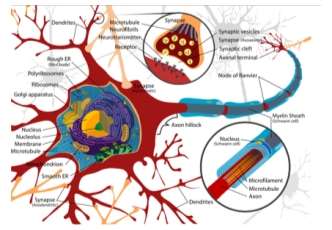
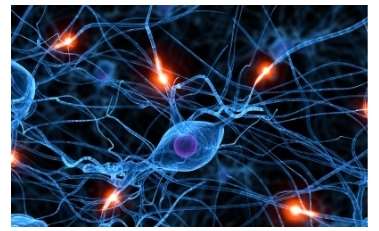
After this lecture, students will have time to ask any questions and discuss their thoughts and understanding of the concept of neurons within small groups. By the end of this session, students will learn about basic properties of neurons and how neurons communicate with each other.
Session 2: Brain structure and Function
In this session, after a brief recalling of last session which was about neurons, few fact cards about brain will be given to students. Next, a brief introduction of brain anatomy and main areas of brains will be given by the help of pictures (figure 3 to 5). For avoiding boredom in students, instead of lecture given by the instructor, they will watch short videos explaining brain’s function. Videos are from an online course offered by University of Toronto
- Facts that are given after figure 3:
- Weight: 3 lbs
- 2% of total body weight
- Consumes 25% of the body’s oxygen supply
- Consumes 70% of the body’s glucose supply
- Consumers 25% of the body’s nutrients
- 100 Billion Neurons
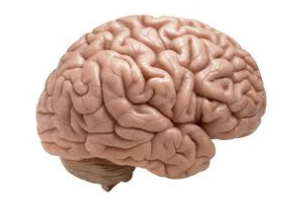
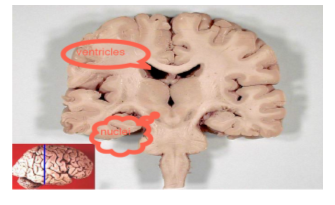


- Facts that are given after figure 4:
- With matter is inside the brain and Gray matter is outside the brain
- Cerebral cortex is wrinkled. The grooves that make these wrinkles are called sulci and the ridges between them are called gyri
- Two hemispheres are connected by Corpus Callosum
- Facts that are given after figure 5:
- Brain has two main parts: cortex which has 4 parts: frontal, temporal, parietal and occipital lobe. and the other part is cerebellum


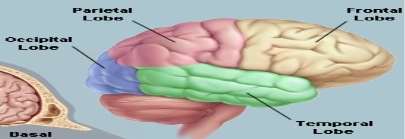
After watching the videos, students will discuss their questions, any misconception that they might have about the brain and gained knowledge in small groups. The session will end by given pictures of brain’s structure and areas that students are required to name them.
Session 3: Neuroplasticity
In this session, the topic of neuroplasticity which is about the electrical and neural changes in the brain during learning will be thought. The lesson plan will be a brief explanation of neuroplasticity by summarizing some researches about this concept:
Plasticity is one of the most essential functions of the human brain. According to Munte et al (2002) “Neuroplasticity allows the brain to adapt to environmental factors that cannot be anticipated by genetic programming”
There are a vast majority of researchers that are interested in this topic and have been examining plasticity via different experiments both on animals and human. One of these researchers named Dr Norman Doidge who is author of “The Brain that Changes Itself”. In his book he talked about the brain as a modifiable, changeable, adaptable and plastic organism that is able to change its function and even structure without chemical reaction in the body, just based on our interaction with the brain. The interesting thing about the power of the brain is, its ability to change structurally even with imagination. Another discovery related to plasticity is the fact that learning changes the number of connection between neurons; even with hours of training the number of connection between two neurons can increase from 1300 to 2700 as an example. The reason how plasticity happen in our brain is: through activities and thoughts that people do with their brain, there are certain genes in nerve cells that become on and others off, this change causes producing protein and protein finally makes change in brain structure. This discovery made a strong proof for the role of learning and training in changing our brain and as a result changing our mind and behavior (Bush et al., 2004). People are able to change their behavior as a result of functional changing in their brain, for example depression is a severe disorder that causes 25% loose of gray matter in hippocampus. This is due to fact that chronic stress release cortisol which gradually weakens the role of left prefrontal cortex, a region that is known as a controller of negative emotion, and the weak activity of PFC causes 25% loose of gray matter in hippocampus. An experiment done in UK showed that the size and amount of gray matter would be the same again after 5 weeks of treatment in depressed people. Similarly, in article written by Draganski et al., (2004) the same finding was reported. Subjects of their experiments were divided into two groups: learner and non-learner. They scanned their subjects’ brain at the beginning of experiment and find that there is no difference between two groups. Then they taught the learner group how to juggle and when their subjects were professional enough to juggle in 1 minute, they had another FMRI scan for both group. For learners the amount of gray matter in the mid-temporal area and in the left posterior intraparietal was increased by 25% compared to non-learner and compared to the first scan. Finally they had third scan after 3 months without training for both group and they found that the amount of gray matter decreased again in learner group. Their finding was consistent with the finding about depression.
Münte et al., (2002) examined neuroplasticity in musicians that had begun their training in early age. They found musicians who began before the age of seven had a larger anterior midsagittal corpus callosum compared to others that started later. Therefore, they were able to have a bidirectional movement. In order to be able to control bidirectional movement, an enhanced interaction between two hemispheres is needed and since number of axons that can be transmitted to other hemisphere depends on size of midsagittal corpus callosum, therefore musicians with larger AMCC were able to have bidirectional movements. Elbert et al., (1995) showed that string players had a larger cortical representation of the digits finger in the left hand compared to non-musicians. They argued that even neuroplasticity was different among musicians depending on their interaction with music and their professional usage of music; for example a conductor is better in understanding non-adjacent and separating adjacent sound sources. Accordingly, there is an automatic movement in musicians body (fingers of hand or even leg) when they just listening to music and vice versa. This is because of co-activation of motor-audio regions in their brain.
After this lecture, students will ask their questions (in case of any) and form small groups to share their ideas about neuroplasticity. During these sessions, students learned how their brain can be manipulated by practicing
By the end of this session, knowledge creation about the brain will be ended. Therefore, in order to test the output of the sessions, they will be required to articulate their learning. They can either create an artifact (brain, neuron), or write a short essay related to neuroplasticity. As Chinn and Sherin (2005) mentioned one of the problem of team work would be more knowledgeable students will do the load of works and some students might be quiet and their learning process might be overestimated if they work in a group. To avoid this problem, each student is required to do articulation alone. They need to complete this task before last session.
Understanding Goal:
By the end of this session, students will understand that brains’ function and even structure can be changed.
Session 4: Mindset Change
This session consists of two parts. First part is the activity part in which students will discover more about brain and brain plasticity.
This part is designed based on embodiment approach. Embodiment in a broad sense could be defined as the study of the subjective role of the body in making sense of life experiences (Kiverstein, 2012). In other words how our bodies influence and shape the way we speak, think, and behave with regard to environmental challenges we face in our daily lives (Gibbs, 2005). Following such a definition the idea of embodied cognition points out to the inter-connection of mind and body and how they both influence each other. Such an idea was raised as a counter-intuitive argument against the mind-body dualism proposed by Rene Descartes in the 17th century which supported a separation between human body and the external world in which body is completely divisible and mind is completely abstract and indivisible. However, this view was challenged by philosophers like Merleau-Ponty (1962) who viewed body as a primordial existence prior to the existence of a reflected world, and understanding of the external world as a reflection of the human’s body. Pointing to the inter-relationship between body, environment, and people’s perception of the environment (i.e. the external world) Merleau-Ponty (1962; 235) writes that “body is the fabric into which all objects are woven, and it is, at least in relation to the perceived world, the general instrument of comprehension” (cited in Gibbs, 2005; p. ).
Drawing from the definition of the embodiment, it can be concluded that acquiring and comprehending knowledge and solving problem are not solely manipulated in the brain. Conversely, it is influenced by the interaction we have with the external world and how our bodies manage to perceive them. According to Lakeoff and Johnson (1980) this relationship is highly represented in numerous metaphorical expressions in the language we use. For example we may say the something is beyond us when we cannot understand what a specific expression refers to. In this case we make a connection between our understanding of physical distance and mental concept of uncertainty in order to show how we feel about it. Using Lakeoff and Johnson’s metaphorical representations, Barsalou (2008, p. 618) through exemplifying the “act of sitting on a chair” argues that embodied learning can take place through activating a perception-action-introspection complex. According to Barsalou (2008) this whole process is an integrated and multimodal representation of current and past sensory experiences which results in comprehending an object.
According to Abrahamson and Lindgren (2014)in order to place the embodiment theory in education there is need to have an embodied design in order for learners approach a problem in a subject matter through their “natural body instinct and movements” (p. 363). However, embodied designs could be challenged from three aspects of the types of activities, materials and artifacts, and facilitation of conceptual development. Accordingly they proposed that each of those challenges could be appropriately met through using initial simple activities which fall within the experiential domain of learners and then gradually move toward more symbolic one. Moreover, the types of materials and artifacts used to promote learning in such kinds of designs should be similar to ones found outside these designs and in unmediated environments. Finally, the movement and body engagement should be facilitated through providing real-time feedback by tutors and teachers to help learners develop their own conceptual insights.
Given this brief explanation of embodiment, students will participate in an activity that will result in understanding how their brain can be manipulated by practicing and how their intelligence could be increased through learning. During activity part, they will go through a ”Neural Network Maze” spelling out the word ”SMARTER” and saw how this network change when they learn something new. This activity is based on BNlackwell et al., (2007).
In the second part students will see some examples of disabled people who were able to manage their disability and succeed in their life. The aim of this activity is showing students that even people who are suffering from major problems and lost their critical abilities (like walking) did not give up and challenge themselves to achieve their goals. An example of disabled people is Nicholas James Vujicic who is an Australian motivational speaker. He was born with tetra-amelia syndrome and has neither arms nor legs, but could graduate college with a bachelor degree in financing and is a successful writer.
Understanding Goal:
- Everyone can be smart, because intelligence is not statistic and unchangeable
- Efforts is the most important factor in improving ability
- The way they think about their ability, can affect their behavior
Session 5: Improving motivation by the help of feedback
In the last session of workshop, students will summarize their learning and will explain how their misconceptions have changed (if changed) and the instructor will give each student the appropriate feedback. Depending on the number of students participated in this workshop, each student will have time to show their artifact or read their essay that was asked to complete it by the end of session 3. Instructor (experimenter) will give feedback for each student’s work because as we already know feedback is one type of reward and it can motivate students and even change extrinsic motivation to intrinsic motivation. Below is a summary of researches that support the effect of reward in increasing students’ motivation and their performance
Harackiewicz (1979) was concerned about relation between feedback, motivation and the outcome and examined this relation among high school students. He found positive feedback increase motivation and motivation increase performance. However he claimed that positive feedback on the performance has different effect compared to reward effect. Positive feedback which is assessed as verbal rewards is known as an unexpected, competence improvement reward and has a significant positive influence on intrinsic motivation.
In two studies that used positive feedback as a motivational resource, they tested how a slightly change in wording can bring a fundamental change in the motivation. In the first study, Ryan (1982) used a controlling feedback by saying: ” Excellent, you should keep up the good work“, whereas in the other study, Pittman et al. (1980) used an informational feedback: ” Compared to most of my subjects, you are doing really well“. The result of these two studies was in line with the claim; in the first statement subjects had less intrinsic motivation after few trials compared to second informational feedback. In conclusion, positive feedback can bring interest for receivers and will increase intrinsic motivation.
O’Dohetry (2004) wrote an excellent review about the underlying mechanism of reward seeking and punishment avoidance in human behaviors. He discussed recent neuroimaging findings which gives insight into the reward representations and reward-related learning process that take place in the human brain. The author highlighted the involvement of ventromedial prefrontal cortex, amygdala, striatum, and dopaminergic midbrain in the reward-related learning process. Providing evidence from human neuroimaging, the author argues that specific reward-induced behaviors are subject to the function of different parts of the aforementioned network. However, no matter which component guides which specific reward-related behavior, the persistence of behavior is dependent on the value assigned to the reward and perhaps the punishment within this network. The importance of the findings reported in this paper is connecting them with goal-directed behavior which requires complex cognitive resources and functionalities. In other words, the complexities involved in choosing between various behaviors and actions are based on evaluation of their “representation of the predicted future rewards” with the selected action having the highest predicted reward which varies depending on the its quality, frequency and variance in specific situations. As stated in the article, there are three main parts of the brain that is responsible for guiding our action. Therefore, our behavior is formed controlled as a response to a value of reward or punishment. The author also made a distinction between these parts and the role of each part in seeking the reward, evaluating the value of reward or punishment, predicting the future reward/punishment and deciding about a proper action based on the prediction of value. As a result becoming motivated in doing an action depends on the value of reward or punishment as well as its amount that is aligned with that action even in future. Our brain and even animals’ brain is able to learn how to guide our action to receive rewards. It means, our brain tracks and analyses the process of gaining a reward for future use just like the classical conditioning situation. Better reward causes more motivation (O’Dohetry, 2004).
Understanding Goal:
- By putting enough efforts, students can increase their performance on school
Reference:
Abrahamson, D., & Lindgren, R. (2014). Embodiment and embodied design. In R. K. Sawyer (ed.)The Cambridge handbook of the learning sciences, pp. 358-376.
Barsalou, L. W. (2008). Grounded cognition. Annual Review of Psychology, 59, 617-645.
Blackwell, L. S., Trzesniewski, K. H., & Dweck, C. S. (2007). Implicit theories of intelligence predict achievement across an adolescent transition: A longitudinal study and an intervention. Child development, 78(1), 246-263.
Busch, V., Schuierer, G., Bogdahn, U., & May, A. (2004). Changes in grey matter induced by training. Nature, 311-312.
Doidge, N. (2007). The brain that changes itself: Stories of personal triumph from the frontiers of brain science. Penguin.
Draganski, B., Gaser, C., Busch, V., Schuierer, G., Bogdahn, U., & May, A. (2004, January 22). Changes in grey matter induced by training. Nature, pp. 247: 311-312.
Elbert, T., Pantev, C., Wienbruch, C., Rockstroh, B., & Taub, E. (1995). Increased cortical representation of the fingers of the left hand in string players. Science, 270(5234), 305.
Galván, A. (2010). Neural plasticity of development and learning. Human Brain Mapping, 31(6), 879-90. doi:10.1002/hbm.21029
Gibbs Jr, R. W. (2005). Embodiment and cognitive science. Cambridge University Press.
Harackiewicz, J. M. (1979). The effects of reward contingency and performance feedback on intrinsic motivation. Journal of Personality and Social Psychology,37(8), 1352.
Kiverstein, J. (2012). The meaning of embodiment. Topics in cognitive science, 4(4), 740-758.
Lakoff, G., & Johnson, M. (1980). Metaphors we live by. Chicago: University of Chicago Press.
Merleau-Ponty, M. (1962). Phenomenology of perception. London: Routledge & Kegan Paul.
Münte, T. F., Altenmüller, E., & Jäncke, L. (2002). The musician’s brain as a model of neuroplasticity. Nature Reviews. Neuroscience, 3(6), 473-8. doi:10.1038/nrn843
O’Doherty, J. P. (2004). Reward representations and reward-related learning in the human brain: insights from neuroimaging. Current opinion in neurobiology,14(6), 769-776.
Pittman, T. S., Davey, M. E., Alafat, K. A., Wetherill, K. V., & Kramer, N. A. (1980). Informational versus controlling verbal rewards. Personality and Social Psychology Bulletin, 6(2), 228-233.
Ryan, R. M. (1982). Control and information in the intrapersonal sphere: An extension of cognitive evaluation theory. Journal of personality and social psychology, 43(3), 450.
Sawyer, R. K. (Ed.). (2005). The Cambridge handbook of the learning sciences. Cambridge University Press.
Cite This Work
To export a reference to this article please select a referencing stye below:
Related Services
View allDMCA / Removal Request
If you are the original writer of this essay and no longer wish to have your work published on UKEssays.com then please click the following link to email our support team:
Request essay removal


